Developing metacognition in your school
Metacognition and revision
Successful students have a range of revision strategies they can select from. They can match revision strategies to the type of test they are revising for. Beyond this, they know how to approach revision (e.g. when to revise, how long to spend on revision, how to break up revision, where to conduct revision).
Judgement of knowing : students who are highly metacognitive are able to more accurately determine 'when they know something' and when 'knowledge and understanding is secure'. They are therefore able to determine how long to spend on different topics when revising. Students who lack this ability often select topics to revise which they already have stored in long term memory (usually the ones they like), spend too long on revision (going past an optimum point, which can cause stress or less time for other activities), or don't spend enough time on revision (falsely believing that they already know the topic). We have all come across students who fall into one of these categories.
We can help pupils to develop their 'judgement of knowing' by:
- giving them structures, time and guidance on assessing what they need to revise (e.g. a list of topics which pupils score on a scale of 0-10 in accordance with how well they think they know the topic).
- providing them with feedback and practice test information to help them decide on priority areas for revision.
- sharing with pupils the the strategies we use to decide if we really know something (e.g. closing the booking and writing out the key points, having someone else test you, answering the end of chapter tests, completing a mind map).
- alerting them to the dangers of inaccurate 'judgement of knowing' so they can improve their own self-regulation.
Revision strategies:
1. Understanding how memory works is beneficial in helping pupils consider how they revise and the techniques they use. There are 7 slots in working memory. To expand the number of items we can hold in our memory it is useful to group items or connect them (e.g. remembering items through the use of a story). We can recall more information when it is linked. It makes it easier to dredge up the information from our memory, and hold it in memory whilst we answer questions. We are more likely to remember things that we understand really well. If we have a shaky understanding, our memory of it fades more quickly. The more memorable, e.g. vivid or outlandish or emotional, we can make the information we are trying to remember, the more likely it is that we will be able to recall it at a later date. Committing information to memory in a multi-sensory way (e.g. hearing, saying, seeing) increases the chances that we will remember the information. Association is therefore an important revision tool that can be used in many different ways.
USE OF IMAGES : it is easier to recall items if there are pictures and images to go with the item than just the items on their own, e.g.
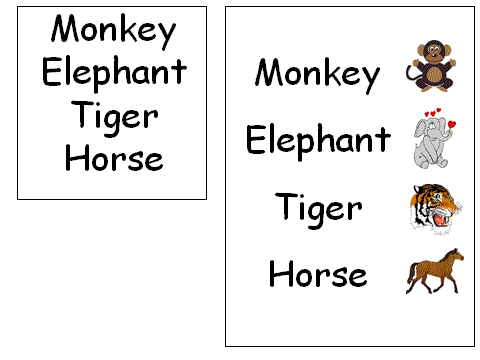
It is easier to recall items if they are grouped, e.g.:
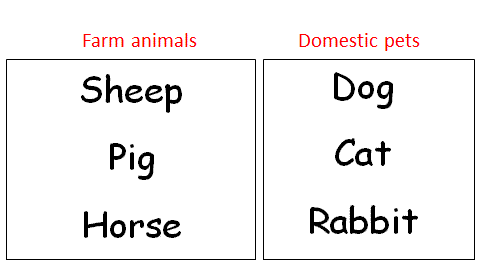
It is easier to recall items if within the group they are linked. E.g. The huge spotty dog jumped over the sleeping cat to grab the rabbit by the tail.
Note taking : Students should be advised to pay careful attention to the process of note taking. Extra time should be allocated by the teacher to enable students to be mindful when selecting what to record and how to record the information. A mindful approach to note taking increases the likelihood of the information being transferred from short term to long term memory. Making notes very visual aids later recall. Boxing up, using colour and images, underlining, using tags to draw attention to key elements, graphic organisers, thinking maps, and diagrams are all presentation methods students should use to help the brain compartmentalise the information. Teachers should encourage pupils to compare and contrast their note taking with each other, discussing what they think are the key concepts, vocabulary and points. This discussion also helps pupils to retain the information and provides an opportunity to answer any questions, address misconceptions, and identify missing points. Time taken in the first place will reap dividends later. This is not about spending time making it 'pretty' but rather the focus is analytical and scientific. Students must understand the science behind effective note taking.
- Students understanding the reasons for adjusting their note taking habits.
- Mindfullness / care / attention to what is being recorded - helps to commit the information to memory.
- Visual aspects - aids later recall.
- Carefully structured - aids revision.

An example of Cornell note taking methods (below)


Mnemonics: useful for recalling linked facts in a sequence. They are also useful for providing structures that can be used to write longer answers, such as essay writing, or for getting more depth into an answer, such as in the example below.
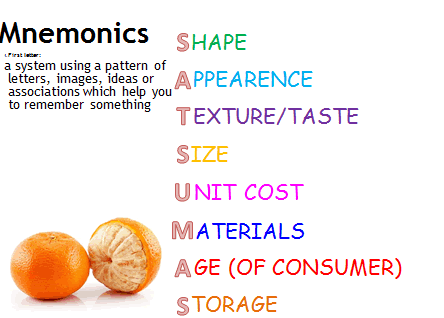
Memory palaces and memory journeys
Students select a familiar place, such as their home. In their heads, they make images to represent different elements of a concept. They mentally place the images around the room. The more vivid and outrageous the images, the more likely the recall. There is a wealth of research and information teachers can tap into to help pupils use memory palaces for revision and visualisation techniques.
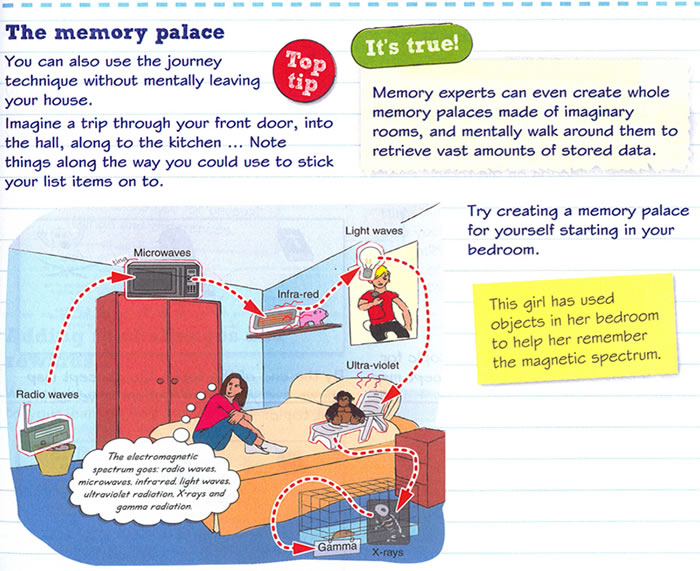
Memory games, testing our memories, developing memory strategies all help. Regular practice helps to improve the effectiveness of memory. A very interesting book on memory is 'Walking with Einstein' by Joshua Foer. Many pupils do not believe they can improve their memories. Research shows us that actually we can!
Visual reminders and production of materials to aid the revision process.
Mind maps, revision cards, large size posters to go up on bedroom walls, colourful lists, etc, can all be of assistance when trying to remember large quantities of information. They can be referred to often, used to test each other and serve as a visual aid.

'Binding rings' are better than treasury tags (cheap to purchase online, e.g. Amazon). The photograph on the right shows colour palettes strips used for selecting paint; a nice idea for revision cards - particularly for remembering multiple points on a theme (e.g. essays).
It is better for students to make cards than to purchase them, as the process of making them and selecting the information is a more active form of revision.
Large scale posters:

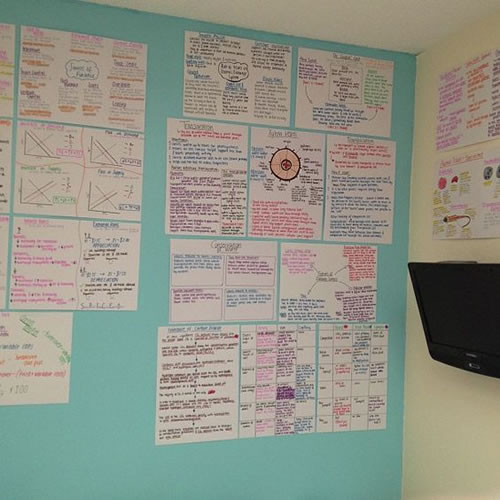
Mindmaps:

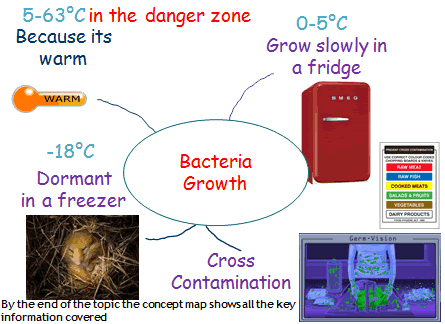
Revision can be creative...
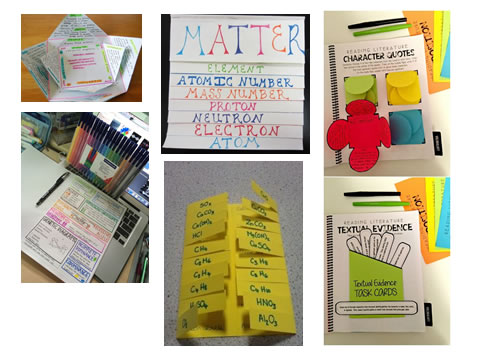
Revision can be collaborative...

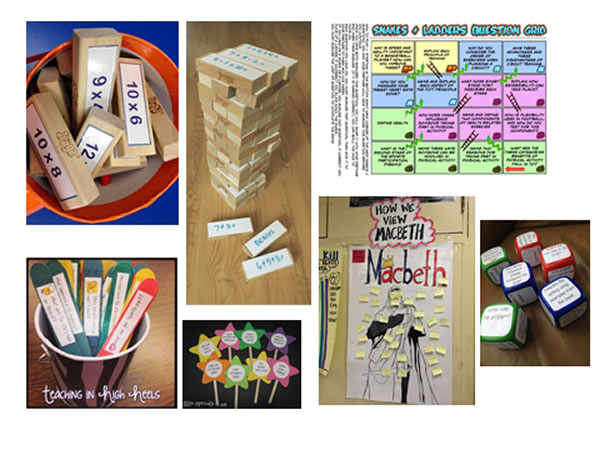
Snakes and ladders and more at... http://www.pe4learning.com/new-gcse-pe-revision-games-resources/
Distributed practice:
- Tests must be built into the revision process, both at home and at school.
- Revisiting tests will diagnose areas of uncertainty and help the pupils to plan their revision.
- Tests used throughout the year should reflect what is needed for the exam in terms of content, complexity, question style etc,.
- Exercise books: it is useful to box key facts and concepts needed for the exam to make them stand out ready for revision time.
- Spread out revision rather than 'massed practice'.
- Students need persuading: it seems slower to revise over a long period of time. They need to know that little and often throughout the year will help them be more effective in their final block of revision.
- Students need help planning - how to use their time, how to break up sessions, what to revise, how to revise.
- Distributed practice tests combine well with learning new revision techniques. The teacher introduces some new techniques, the pupils them use the techniques on the practice tests, the teacher then helps them evaluate the effectiveness of the strategies. Give students the opportunity to resit tests using different strategies to revise.
Metacognition :
- Increase pupil awareness of the many variables that go into effective and successful revision.
- Explicitly teach revision strategies to increase pupils knowledge of different techniques they can use. Share and discuss strategies with each other.
- Give pupils a chance to try out their revision strategies.
- Help them to evaluate and modify their revision strategies after they have used them in tests.
- Increase their understanding of how their brain works. Help them to have an increased understanding of memory.
- Help them to have increased self-awareness : when is the best time of day/night for them to study, what size time blocks work best for them, what tools do they find useful, how would they rate their organisational abilities and what could they do to improve, what do they find are barriers to revision and how could they remove them, what type of environment do they study best in...etc,.
- Support them in using revision time wisely.
- Model your use of revision techniques.
Links
![]()
Like to share?
Why not send us your resources.